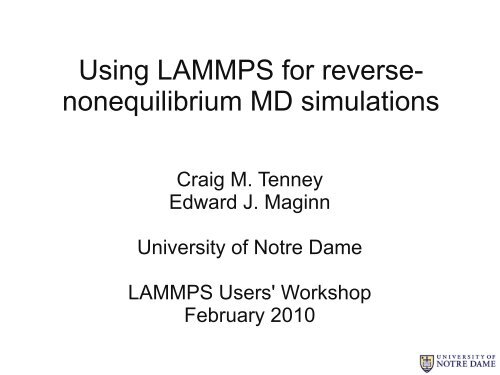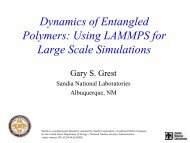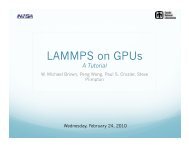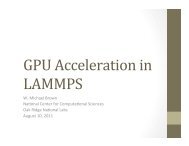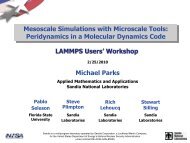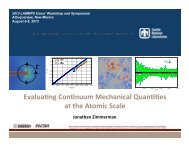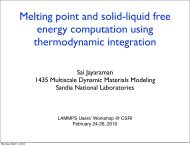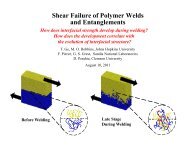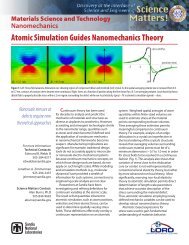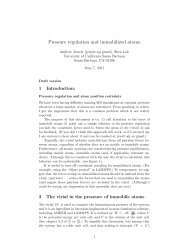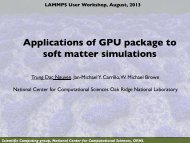Using LAMMPS for reverse-NEMD simulations
Using LAMMPS for reverse-NEMD simulations
Using LAMMPS for reverse-NEMD simulations
You also want an ePaper? Increase the reach of your titles
YUMPU automatically turns print PDFs into web optimized ePapers that Google loves.
<strong>Using</strong> <strong>LAMMPS</strong> <strong>for</strong> <strong>reverse</strong>nonequilibrium<br />
MD <strong>simulations</strong><br />
Craig M. Tenney<br />
Edward J. Maginn<br />
University of Notre Dame<br />
<strong>LAMMPS</strong> Users' Workshop<br />
February 2010
motivation<br />
●<br />
●<br />
want to predict viscosity and thermal<br />
conductivity <strong>for</strong> arbitrary fluids...<br />
●<br />
●<br />
●<br />
●<br />
accurately<br />
precisely<br />
efficiently<br />
reliably<br />
numerous molecular simulation methods exist<br />
●<br />
“best” is rarely obvious a priori
content<br />
●<br />
●<br />
●<br />
calculation of shear viscosity<br />
●<br />
●<br />
●<br />
●<br />
background<br />
non-linearity issues<br />
avoiding pitfalls<br />
comparison with other methods<br />
calculation of thermal conductivity<br />
summary
ackground<br />
●<br />
shear viscosity:<br />
flux of transverse linear momentum =<br />
shear viscosity * shear rate<br />
j z =−⋅<br />
= v x<br />
z<br />
Newtonian: 0<br />
as 0<br />
Muller-Plathe, Phys. Rev. E 59, 1999
MD methods <strong>for</strong> viscosity calculation<br />
●<br />
●<br />
transient<br />
●<br />
growth or decay of velocity perturbation<br />
steady-state<br />
●<br />
●<br />
equilibrium<br />
– auto-correlation of fluctuations in flux or shear<br />
– e.g. Einstein or Green-Kubo relations<br />
non-equilibrium<br />
– e.g. SLLOD<br />
●<br />
set shear rate and measure momentum flux<br />
– <strong>reverse</strong>-<strong>NEMD</strong> (R<strong>NEMD</strong>)<br />
●<br />
set momentum flux and measure shear rate
1) set shear rate via …<br />
● Lees-Edwards sliding-brick BCs or ...<br />
●<br />
SLLOD (<strong>NEMD</strong>) algorithm<br />
(fix nvt/sllod)<br />
de<strong>for</strong>ming simulation box<br />
2) measure resulting momentum flux j = <br />
(thermostat must account<br />
<strong>for</strong> velocity profile)<br />
Evans and Morriss, Statistical Mechanics of Non-equilibrium Liquids (1990)
R<strong>NEMD</strong> algorithm<br />
(fix viscosity)<br />
1) from bottom and middle bins, find two particles<br />
with “slow” v x<br />
(relative to mean bin v x<br />
)<br />
2) swap v x<br />
between these particles<br />
3) measure resulting<br />
velocity profile<br />
(conserves energy)<br />
Muller-Plathe, Phys. Rev. E 59, 1999
R<strong>NEMD</strong> algorithm<br />
1) from bottom and middle bins, find two particles<br />
with “slow” v x<br />
(relative to mean bin v x<br />
)<br />
2) swap v x<br />
between these particles<br />
3) measure resulting<br />
velocity profile<br />
(conserves energy)<br />
Muller-Plathe, Phys. Rev. E 59, 1999
simulation details<br />
(similar to original Muller-Plathe (MP) paper)<br />
●<br />
Lennard-Jones fluid<br />
● reduced density = 0.849<br />
● reduced temperature = 0.722<br />
●<br />
R<strong>NEMD</strong><br />
●<br />
●<br />
●<br />
●<br />
3000 particles<br />
10.56 x 10.56 x 31.68 σ (aka “10x10x30”)<br />
20 bins<br />
500k steps<br />
● reduced timestep = 0.005
R<strong>NEMD</strong> viscosity example<br />
●<br />
“base case”<br />
●<br />
swap target v x<br />
every 1 step<br />
●<br />
momentum flux = 0.0466<br />
(equivalent to swapping “slowest”<br />
v x<br />
every 60 steps)<br />
●<br />
L z<br />
~ “30” σ
R<strong>NEMD</strong> viscosity example<br />
●<br />
“base case”<br />
●<br />
swap target v x<br />
every 1 step<br />
●<br />
momentum flux = 0.0466<br />
(equivalent to swapping “slowest”<br />
v x<br />
every 60 steps)<br />
●<br />
L z<br />
~ “30” σ<br />
● dv x<br />
/dz = 0.0142<br />
→ η = 3.28 (+/- 0.05)<br />
500k steps, 3000 particles
R<strong>NEMD</strong> viscosity example<br />
●<br />
“base case”<br />
●<br />
swap target v x<br />
every 1 step<br />
●<br />
momentum flux = 0.0466<br />
(equivalent to swapping “slowest”<br />
v x<br />
every 60 steps)<br />
●<br />
L z<br />
~ “30” σ<br />
● dv x<br />
/dz = 0.0142<br />
→ η = 3.28 (+/- 0.05)<br />
500k steps, 3000 particles<br />
● SLLOD: η = 3.40 (+/- 0.12)<br />
500k steps, 1000 particles<br />
● EMD: η 0<br />
= 3.35 (+/- 0.25)<br />
1M steps, 1000 particles
R<strong>NEMD</strong> at high momentum flux<br />
base case
R<strong>NEMD</strong> at high momentum flux<br />
base case<br />
~4x flux increase
R<strong>NEMD</strong> at high momentum flux<br />
base case<br />
~4x flux increase<br />
~5x flux increase<br />
high momentum flux → non-linear velocity profile
ase case<br />
R<strong>NEMD</strong> non-linearity
R<strong>NEMD</strong> non-linearity<br />
base case<br />
~4x flux increase
R<strong>NEMD</strong> non-linearity<br />
base case<br />
~4x flux increase ~5x flux increase
R<strong>NEMD</strong> non-linearity<br />
base case<br />
~4x flux increase<br />
~5x flux increase<br />
2x L z<br />
increase<br />
in theory …<br />
but it looks like …<br />
T = L 2 2<br />
z<br />
j z<br />
32<br />
N −2 N −4<br />
N 2<br />
ΔT ~ L z 2<br />
j z<br />
Tenney and Maginn, J. Chem. Phys 132, 2010
R<strong>NEMD</strong> non-linearity<br />
●<br />
●<br />
swap moves conserve energy, but …<br />
they remove heat (entropy) from swap bins<br />
~20x base case flux<br />
Tenney and Maginn, J. Chem. Phys 132, 2010
setting R<strong>NEMD</strong> momentum flux<br />
base case
setting R<strong>NEMD</strong> momentum flux<br />
target flux ΔT actual flux<br />
high excessive < target<br />
moderate reasonable just right<br />
low negligible ≥ target<br />
base case<br />
Tenney and Maginn, J. Chem. Phys 132, 2010
R<strong>NEMD</strong> at low momentum flux<br />
swap every 10 steps<br />
~20% base case flux<br />
swap every 100 steps
R<strong>NEMD</strong> at low momentum flux<br />
swap every 10 steps<br />
~20% base case flux<br />
swap every 100 steps<br />
~5% base case flux<br />
4x longer simulation<br />
(2M steps)<br />
Tenney and Maginn, J. Chem. Phys 132, 2010
R<strong>NEMD</strong>, SLLOD, and EMD results<br />
base case<br />
●<br />
SLLOD results fit to Curreau equation:<br />
=<br />
0<br />
, where =shear rate<br />
1 2 <br />
<br />
Tenney and Maginn, J. Chem. Phys 132, 2010
R<strong>NEMD</strong> viscosity summary<br />
●<br />
●<br />
●<br />
potential advantages<br />
●<br />
●<br />
NVE ensemble<br />
shear profile is not imposed by de<strong>for</strong>ming space<br />
disadvantages<br />
●<br />
●<br />
fails at high momentum flux<br />
“pulse” issues at low flux<br />
ambiguities<br />
●<br />
comparable computational efficiency
R<strong>NEMD</strong> thermal conductivity<br />
Muller-Plathe, J. Chem. Phys. 106, 1997<br />
●<br />
●<br />
swap kinetic energy instead of momentum<br />
fix thermal/conductivity<br />
●<br />
example: ionic liquid @ 373K
R<strong>NEMD</strong> thermal conductivity
R<strong>NEMD</strong> thermal conductivity
R<strong>NEMD</strong> thermal conductivity<br />
●<br />
other options<br />
●<br />
swap between atoms of any mass (<strong>LAMMPS</strong> mod)<br />
– hypothetical elastic collision<br />
– available if Steve wants it<br />
●<br />
swap molecular (c.o.m) kinetic energy<br />
– allows constraints<br />
– probably more expensive (not implemented in <strong>LAMMPS</strong>)<br />
– possibly better energy conservation<br />
●<br />
instead of swapping, thermostat hot and cold bins<br />
– track steady-state flux<br />
– compute temp/region, fix langevin
conclusions<br />
●<br />
●<br />
●<br />
R<strong>NEMD</strong> can efficiently provide good viscosity<br />
results <strong>for</strong> 'moderate' shear rates<br />
R<strong>NEMD</strong> is less robust than SLLOD<br />
if SLLOD or EMD won't work, consider R<strong>NEMD</strong><br />
●<br />
R<strong>NEMD</strong> thermal conductivity calculations are<br />
less finicky than viscosity calculations
acknowledgments<br />
●<br />
●<br />
●<br />
members of the Maginn group (particularly Sai,<br />
<strong>for</strong> sharing his <strong>LAMMPS</strong> scripts)<br />
U.S. Department of Energy<br />
University of Notre Dame Center <strong>for</strong> Research<br />
Computing
about R<strong>NEMD</strong> statistics<br />
●<br />
●<br />
we want the uncertainty of =-j/<br />
from the mean value theorem, <strong>for</strong> a reasonable<br />
number N of independent calculations of a …<br />
a ≈ 〈a〉 ±<br />
〈a2 〉−〈a〉 2<br />
N<br />
●<br />
●<br />
but at low flux, oscillates around 0+ , so blows up<br />
consequently, we used a propogation-of-error model:<br />
= 2 j 2


